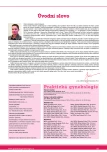Targeted – biological treatment of ovarian cancer
Authors:
Josef Chovanec
Authors‘ workplace:
Oddělení gynekologické onkologie, Masarykův onkologický ústav Brno
Published in:
Prakt Gyn 2011; 15(3-4): 158-161
Category:
Review Article
Overview
Epithelial ovarian cancer is the second most common gynaecological malignancy and it is the gynaecological malignancy with the highest morbidity. Primary treatment for this cancer consists of surgical cytoreduction and platinum-based chemotherapy. The majority of women with advanced disease, even those who achieve complete remission, eventually experience relapse. A variety of emerging agents with novel targets are currently under development for ovarian cancer. Several of these agents target angiogenesis – a process of new blood vessel and lymphatic cell development. Angiogenesis is critical to the growth and progression of solid tumours. In recent years, many specific new inhibitors of angiogenesis have been developed. This, so called, targeted therapy uses monoclonal antibodies or other substances to identify and attack specific cancer cells. Vascular endothelial growth factor appears to be the most promising target. Bevacizumab represents a great progress in targeted therapy of ovarian cancer. Targeted biological therapy is currently the most active area of cancer treatment research.
Key words:
ovarian cancer – targeted therapy – bevacizumab – inhibitors of tyrosinkinases
Sources
1. Clarke CH, Yip C, Badgwell D et al. Proteo-mic biomarkers apolipoprotein A1, trunca-ted transthyretin and connective tissue activating protein III enhance the sensitivity of CA125 for detecting early stage epithelial ovarian cancer. Gynecol Oncol 2011; 122(3): 548–553.
2. Hellstrom I, Hellstrom KE. fTwo novel biomarkers, mesothelin and HE4, for diagnosis of ovarian carcinoma. Expert Opin Med Diagn 2011; 5(3): 227–240.
3. Brychtova V, Vojtesek B, Hrstka R. Anterior gradient 2: a novel player in tumor cell biology. Cancer Lett 2011; 304(1): 1–7.
4. Korbel RS. Tumor angiogenesis. N Engl J Med 2008; 338 : 2039–2049.
5. Klener P. Inhibice angiogeneze v léčbě zhoubných nádorů. Farmakoterapie 2010; 6(5): 522–525.
6. Hurwitz H, Fehrenbacher L, Novotny W et al. Bevacizumab plus irinotecan, fluorouracil, and leucovorin for metastatic colorectal cancer. N Engl J Med 2004; 350(23): 2335–2342.
7. Yamamoto S, Konishi I, Mandai M et al. Expression of vascular endothelial growth factor (VEGF) in epithelial ovarian neoplasms: correlation with clinicopathology and patient survival, and analysis of serum VEGF levels. Br J Cancer 1997; 76(9): 1221–1227.
8. Burger RA, Brady MF, Bookman MA et al. Phase III trial of bevacizumab (BEV) in the primary treatment of advanced epithelial ovarian cancer, primary peritoneal cancer or fallopian tube cancer: a gynecologic oncology group study. J Clin Oncol 2010; 28 (Suppl 18): Abstract LBA1.
9. Perren TJ et al. Avastin ICON7: Abstract of the 35th ESMO Congress. Ann Oncol 2010; 21 (Suppl 8): Abstract LBA4.
10. Kristensen G, Perren TJ, Qian W et al. Results of interim analysis of overall survival in the GCIG ICON phase III randomized trial of bevacizumab in women with newly diagnosed ovarian cancer. J Clin Oncol 2011; 29 (Suppl 18): Abstract LBA5006.
11. Aghajanian C, Finkler NJ, Rutherford T et al. OCEANS: a randomised, double -blinded, placebo-controlled phase III trial of chemotherapy with or without bevacizumab in patients with platinum-sensitive recurrent epithelial ovarian, primary peritoneal or fallopian tube cancer. J Clin Oncol 2011; 29 (Suppl 18): Abstract LBA5007.
12. Coleman, RL. 2011 Annual Meeting of the American Society of Clinical Oncology. Abstrakt 5017.
13. Burger RA. Overview og anti-angiogenic agents in development for ovarian cancer. Gynecol Oncol 2011; 121(1): 230–238.
14. Kamat AA, Kim TJ, Landen CN Jr et al. Metronomic chemotherapy enhances the efficacy of antivascular therapy in ovarian cancer. Cancer Res 2007; 67(1): 281–288.
Labels
Paediatric gynaecology Gynaecology and obstetrics Reproduction medicineArticle was published in
Practical Gynecology

2011 Issue 3-4
Most read in this issue
- Prolapsus uteri at vaginae totalis with Mayer’s pessary
- Applications of GnRH analogues in infertility treatment
- Cornual pregnancy carried to full term
- The reasons for severe ovarian hyperstimulation syndrome in patients requiring hospitalisation
